

|
USAF OCS Class 62-A |
|
Bits N Pieces
This page is used to post items the class thinks might be interesting to our members. How long the items remain has not been determined, but since some are news items, they may only appear for a few weeks. If class members would like them to be permanent, that can be done and suggestions as to where on the website to post them should be forwarded along with the request to make the item(s) a permanent part of our site. Please submit your suggestions to |
|
Click link to view 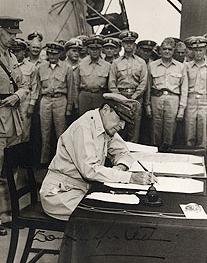 Gen MacArthur Accepting Japanese Surrender Ending WWII All You MacArthur Fans, Check This Out MacArthur Speaks at Congress / West Point 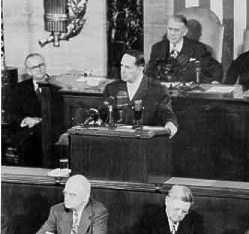
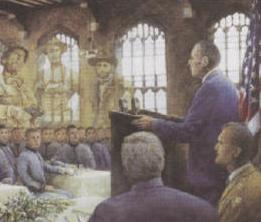 * * * * * * * * * * * * * *
The Virtual Wall * * * * * * * |
|
Congress honors Tuskegee Airmen with award by John J. Kruzel American Forces Press Service
WASHINGTON (AFRNS) -- Before a U.S. aircraft broke the sound barrier, the Tuskegee Airmen overcame a daunting social hurdle: breaking the Air Force's color barrier.
In the Capitol Rotunda here March 29, 2007, President Bush and Congress awarded the Congressional Gold Medal to the Tuskegee Airmen, more than 60 years after the 332nd Fighter Group's World War II achievements that were made bittersweet by the racial discrimination they endured after returning home.
"I thank you for the honor you have brought to our country, and the medal you are about to receive means that our country honors you," President Bush said to the roughly 300-member audience of surviving Airmen, Tuskegee Airmen widows and other relatives, before presenting the congressional award.
President Bush said he has a strong interest in World War II Airmen because one raised him.
"(My father) flew with a group of brave young men who endured difficult times in the defense of our country. Yet for all they sacrificed and all they lost, in a way they were very fortunate," he said. "They never had the burden of having their every mission, their every success, their every failure viewed through the color of their skin; ... nobody refused their salutes."
The Tuskegee Airmen fought two wars -- one in the European theater and another in the hearts and minds of the nation's citizens, he said.
Saying he wanted to "offer a gesture to help atone for all the unreturned salutes and unforgivable indignities," President Bush held his straightened right hand to his brow and saluted the Airmen. After returning his salute, the Airmen remained standing and applauded.
Speaking on behalf of the Tuskegee Airmen, Dr. Roscoe Brown, a former commander of the 100th Fighter Squadron, 332nd Fighter Group, thanked President Bush and the House and Senate for "voting unanimously to award this medal collectively to the pilots, bombardiers, the navigators, the mechanics, the ground officers, the enlisted men and women who served with the Tuskegee Airmen."
"Over 60 years ago we were flying in the skies over Europe defending our country, and at the same time fighting the battle against racial segregation," he said. "Because of our great record and our persistence, we inspired revolutionary reform which led to integration in the armed forces in 1948. As the president said, (this) provided a symbol for America that all people can contribute to this country and be treated fairly."
Dr. Brown, a Distinguished Flying Cross recipient and the first U.S. pilot to down a German Messerschmitt jet, said that the Tuskegee Airmen are very pleased to have been in the forefront of the struggle for freedom and justice in this country.
Sen. Carl Levin and Rep. Charles Rangel were the chief congressional champions in the House and Senate to get the medal awarded to the airmen.
"Nobody, white or black, in this country can understand how God has given you so much courage," Congressman Rangel said, addressing the airmen. "From a nation that had rejected you because of your color, said you couldn't fly, said you just weren't worthy, you had to go out there and prove to them just how wrong they were.
"And how tragic was it to see, ... after you came back to this great country, how German prisoners of war were treated better than you were on your return?" he said. "But somehow, whatever God had given you, it didn't cause you to stop. Every one of you in the different towns that I've been to are still continuing to protect this great country, though perhaps not in the skies, but in the battles on the streets, talking to the kids, giving them self-esteem."
Levin listed some of the airmen's feats: 15,000 combat sorties flown, 260 enemy aircraft destroyed, 1,000 black pilots flew missions, 150 Flying Crosses and Legions of Merit earned, and more than 700 Air Medals and clusters earned.
Recognizing other black groundbreakers, former U.S. Secretary of State and retired Army Gen. Colin L. Powell named the Golden 13, the Montford Point Marines and the 555th Paratroopers -- the Tuskegee Airmen's naval, Marine, and Army counterparts, respectively.
"I benefited from what you and so many others did. It is a rich history," he said. "I stand so proudly before you today but I know in the depth of my heart that the only reason I'm able to stand proudly before you today is because you stood proudly for America 60 years ago."
Related Sites:
|
President George W. Bush salutes
Jess Majors sings the
23rd Psalm during
President George W.
Bush speaks during the Congressional Gold
A member of the
Tuskegee Airmen stands with his hand over his heart during the National
Anthem Thursday, March 29, 2007, at
President George W.
Bush presents the Congressional Gold Medal Dr. Roscoe Brown Jr., during
ceremonies honoring the Tuskegee Airmen Thursday, March 29, 2007, at the
U.S. Capitol. Dr. Brown, Director of the Center for Urban Education
Policy and University Professor at the Graduate School and University
Center of the
President George W.
Bush and Speaker of the House Nancy Pelosi join 300
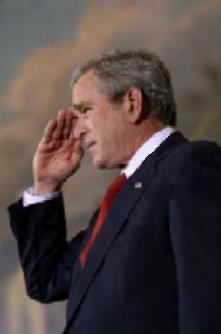
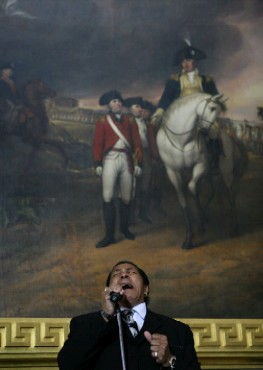
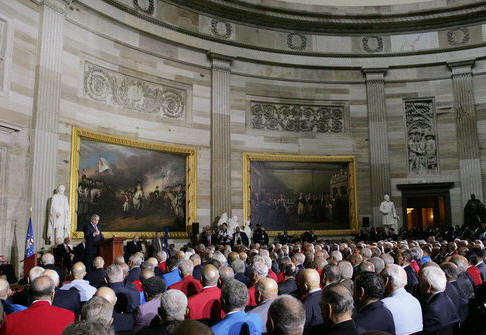
members of the Tuskegee Airmen
during ceremonies at the U.S. Capitol
Thursday, March 29, 2007...
I salute you for the service to the
United States of America.”
White House photo
by Eric Draper
ceremonies Thursday, March 29,
2007, at the U.S. Capitol honoring
the Tuskegee Airmen with the
Congressional Gold Medal.
White House photo
by Eric Draper
Medal ceremony for the Tuskegee Airmen Thursday, March 29,
2007, at the U.S. Capitol. Said the President, “The Tuskegee
Airmen helped win a war, and you helped change our nation
for the better. Yours is the story of the human spirit, and it
ends like all great stories do – with wisdom and lessons
and hope for tomorrow.”
White House photo by Joyce Boghosian

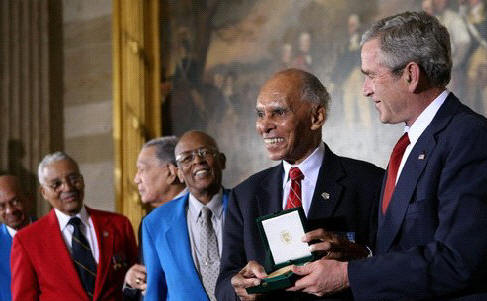
the U.S. Capitol where he and his fellow airmen were bestowed
the Congressional Gold Medal, the highest civilian award
bestowed by the United States Congress.
White House photo by Eric Draper
City University of New York, commanded the 100th Fighter
Squadron of the 332 Fighter Group during World War II.
White House photo by Eric Draper
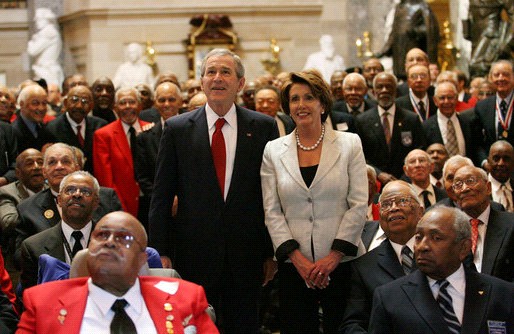
Tuskegee Airmen Statuary Hall at the U.S. Capitol for a photograph
Thursday,
March 29, 2007. The group photo was part of the Congressional Gold
Medal
ceremony honoring America’s first African-American military airmen.
White House photo by Eric Draper
|
Click here to listen to a song that will stir memories. This recording was provided by Don Gray, USAF
OCS Class 58C, who wrote: ----------- |
|
Remember Bill Menkevich? He was with us right up until graduation day and is an honorary class member. The FAA presented him with the Wright Brothers Master Pilot Award during the 2009 Minnesota Wing Conference. |
|
IT WAS A FORTRESS COMING HOME They could hear it before they could see it! Not all that unusual in those days as the personnel at Station 131 gathered around the tower and scattered hardstands to await the return of the B-17's sent out earlier that morning. First comes the far off rumble and drone of the Cyclones. Then a spec on the East Anglia horizon. Soon a small cluster indicating the lead squadron. Finally, the group. Then the counting. 1-2-3-4-5... But that would have been normal. Today was different! It was too early for the group to return. "They're 20 minutes early. Can't be the 398th." They could hear it before they could see it! Something was coming home. But what? All eyes turned toward the northeast, aligning with the main runway, each ground guy and stood-down airman straining to make out this "wail of a Banshee," as one called it. Not like a single B-17 with its characteristic deep roar of the engines blended with four thrashing propellers. This was a howl! Like a powerful wind blowing into a huge whistle. Then it came into view. It WAS a B-17! Low and pointing her nose at the 6,000 foot runway, it appeared for all the world to be crawling toward the earth, screaming in protest. No need for the red flares. All who saw this Fort knew there was death aboard. "Look at that nose!" they said as all eyes stared in amazement as this single, shattered remnant of a once beautiful airplane glided in for an unrealistic "hot" landing. She took all the runway as the "Banshee" noise finally abated, and came to an inglorious stop in the mud just beyond the concrete runway. Men and machines raced to the now silent and lonely aircraft. The ambulance and medical staff were there first. The fire truck... ground and air personnel... jeeps, truck, bikes... Out came one of the crew members from the waist door, then another. Strangely quiet. The scene was almost weird. Men stood by as if in shock, not knowing whether to sing or cry. Either would have been acceptable. The medics quietly made their way to the nose by way of the waist door as the remainder of the crew began exiting. And to answer the obvious question, "what happened?" "What happened?" was easy to see. The nose was a scene of utter destruction. It was as though some giant aerial can opener had peeled the nose like an orange, relocating shreds of metal, plexiglas, wires and tubes on the cockpit windshield and even up to the top turret. The left cheek gun hung limp, like a broken arm. One man pointed to the crease in chin turret. No mistaking that mark! A German 88 anti-aircraft shell had exploded in the lap of the togglier. This would be George Abbott of Mt. Labanon, PA. He had been a waist gunner before training to take over the bombardier's role. Still in the cockpit, physically and emotionally exhausted, were pilot Larry deLancey and co-pilot Phil Stahlman. Navigator Ray LeDoux finally tapped deLancey on the shoulder and suggested they get out. Engineer turret gunner Ben Ruckel already had made his way to the waist was exiting along with radio operator Wendell Reed, ball turret gunner Al Albro, waist gunner Russell Lachman and tail gunner Herbert Guild. Stahlman was flying his last scheduled mission as a replacement for regular co-pilot, Grady Cumbie. The latter had been hospitalized the day before with an ear problem. Lachman was also a "sub," filling in for Abbott in the waist. DeLancey made it as far as the end of the runway, where he sat down with knees drawn up, arms crossed and head down. The ordeal was over, and now the drama was beginning a mental re-play. Then a strange scene took place. Group CO Col. Frank P. Hunter had arrived after viewing the landing from the tower and was about to approach DeLancey. He was physically restrained by flight surgeon Dr. Robert Sweet. "Colonel, that young man doesn't want to talk now. When he is ready you can talk to him, but for now leave him alone." Sweet handed pills out to each crew member and told them to go to their huts and sleep. No dramatics, no cameras, no interviews. The crew would depart the next day for "flak leave" to shake off the stress. And then be expected back early in November. (Just in time to resume "normal" activities on a mission to Merseburg!) Mission No. 98 from Nuthampstead had begun at 0400 that morning of October 15, 1944. It would be Cologne (again), led by CA pilots Robert Templeman of the 602nd, Frank Schofield of the 601st and Charles Khourie of the 603rd. Tragedy and death appeared quickly and early that day. Templeman and pilot Bill Scott got the 602nd off at the scheduled 0630 hour, but at approximately 0645 Khouri and pilot Bill Meyran and their entire crew crashed on takeoff in the town of Anstey. All were killed. Schofield and Harold Stallcup followed successfully with the 601st, with DeLancey flying on their left wing in the lead element. The ride to the target was routine, until the flak started becoming "unroutinely" accurate. "We were going through heavy flak on the bomb run," remembered DeLancey. "I felt the plane begin to lift as the bombs were dropped, then all of a sudden we were rocked by a violent explosion. My first thought - 'a bomb exploded in the bomb bay' - was immediately discarded as the top of the nose section peeled back over the cockpit blocking the forward view." "It seemed like the whole world exploded in front of us," added Stahlman. "The instrument panel all but disintegrated and layers of quilted batting exploded in a million pieces. It was like a momentary snowstorm in the cockpit." It had been a direct hit in the nose. Killed instantly was the togglier, Abbott. Navigator LeDoux, only three feet behind Abbott, was knocked unconscious for a moment, but was miraculously was alive. Although stunned and bleeding, LeDoux made his way to the cockpit to find the two pilots struggling to maintain control of an airplane that by all rights should have been in its death plunge. LeDoux said there was nothing anyone could do for Abbott, while Ruckel opened the door to the bomb bay and signaled to the four crewman in the radio room that all was OK - for the time being. The blast had torn away the top and much of the sides of the nose, depositing enough of the metal on the windshield to make it difficult for either of the pilots to see. "The instrument panel was torn loose and all the flight instruments were inoperative with the exception of the magnetic compass mounted in the panel above the windshield. And its accuracy was questionable. The radio and intercom were gone, the oxygen lines broken, and there was a ruptured hydraulic line under my rudder pedals," said DeLancey. All this complicated by the sub-zero temperature at 27,000 feet blasting into the cockpit. "It was apparent that the damage was severe enough that we could not continue to fly in formation or at high altitude. My first concern was to avoid the other aircraft in the formation, and to get clear of the other planes in case we had to bail out. We eased out of formation, and at the same time removed our oxygen masks as they were collapsing on our faces as the tanks were empty." At this point the formation continued on its prescribed course for home - a long, slow turn southeast of Cologne and finally westward. DeLancey and Stahlman turned left, descending rapidly and hoping, they were heading west. (And also, not into the gun sights of German fighters.) Without maps and navigation aids, they had difficulty getting a fix. By this time they were down to 2,000 feet. "We finally agreed that we were over Belgium and were flying in a southwesterly direction," said the pilot. "About this time a pair of P-51's showed up and flew a loose formation on us across Belgium. I often wondered what they thought as they looked at the mess up front." "We hit the coast right along the Belgium-Holland border, a bit farther north than we had estimated. Ray said we were just south of Walcheren Island." Still in an area of ground fighting, the plane received some small arms fire. This gesture was returned in kind by Albro, shooting from one of the waist guns. "We might have tried for one of the airfields in France, but having no maps this also was questionable. Besides, the controls and engines seemed to be OK, so I made the decision to try for home." "Once over England, LeDoux soon picked up landmarks and gave me course corrections taking us directly to Nuthampstead. It was just a great bit of navigation. Ray just stood there on the flight deck and gave us the headings from memory." Nearing the field, Stahlman let the landing gear down. That was an assurance. But a check of the hydraulic pump sent another spray of oil to the cockpit floor. Probably no brakes! Nevertheless, a flare from Ruckel's pistol had to announce the "ready or not" landing. No "downwind leg" and "final approach" this time. Straight in! "The landing was strictly by guess and feel," said DeLancey. "Without instruments, I suspect I came in a little hot. Also, I had to lean to the left to see straight ahead. The landing was satisfactory, and I had sufficient braking to slow the plane down some. However, as I neared the taxiway, I could feel the brakes getting 'soft'. I felt that losing control and blocking the taxiway would cause more problems than leaving the plane at the end of the runway." That consideration was for the rest of the group. Soon three squadrons of B-17's would be returning, and they didn't need a derelict airplane blocking the way to their respective hardstands. Stahlman, supremely thankful that his career with the 398th had come to an end, soon returned home and in due course became a captain with Eastern Airlines. Retired in 1984, Stahlman said his final Eastern flight "was a bit more routine" than the one 40 years before. DeLancey and LeDoux received decorations on December 11, 1944 for their parts in the October 15 drama. DeLancey was awarded the Silver Star for his "miraculous feat of flying skill and ability" on behalf of General Doolittle, CO of the Eighth Air Force. LeDoux for his "extraordinary navigation skill", received the Distinguished Flying Cross.
The
photos below show the extensive damage to this crew's B-17
|
|
|